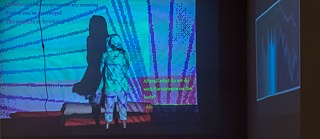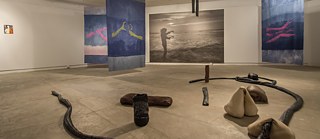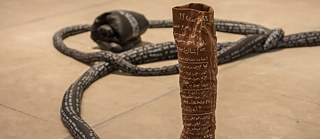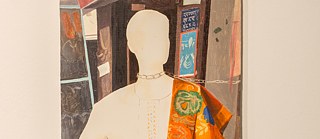New exhibition by the Goethe-Institut Karachi
Limitations, Possibilities, and the Spaces in Between

We become through language and can just as easily be undone by it: Commissioned by Goethe-Institut Karachi the exhibition “Is it Possible to Live Outside of Language?” offers a timely reflection on the exclusion of diverse voices. With acknowledgement and appreciation for bodies that language has often failed to honor, the art works presented attempt to reimagine possibilities for the written, the spoken, and the ineffable.
By Umair Khan
On 22nd August, “Is it Possible to Live Outside of Language?” opened at The Indus Valley School of Art and Architecture in collaboration with Vasl Artists' Association. Curated by Aziz Sohail, a young curator from Karachi selected for the Curatorial Intensive South Asia 2018 program by the Goethe-Institut, the exhibition is a pastiche of exploratory and inquisitive art practices. The works exhibited collectively navigate through questions about the limitations of language, its inability to define the experience, gender identities, and sexualities of those that exist in the liminal spaces between its porous encapsulations.
A mystical power
Language designates, defines, describes; and curiously, somewhere in this process, it ends up prescribing and proscribing. Words hold a tremendous, perhaps even mystical power over our lives. We learn, internalize, and perform language and it in turn molds our becoming as subjects - as selves locked in spatiotemporal flux. We become through language and can just as easily be undone by it. Some bodies are cut off from mere recognition and intelligibility under the razor sharp categorizations that words produce. Aziz Sohail's collaborative project is a conversation with these recognitions and the art showcased offers palpable insights and reflections.New ways of embodiment
Featuring works by artists from Karachi, as well as contributions from Berlin-based Lucas Odahara, the project addresses the highly generative tension in the space between the descriptive, the prescriptive, and the inarticulable. In doing so, it seeks to ignite new ways of embodying and expressing that move from the erasure of identities to their celebration. It envisions a living-with-language that flourishes the expressions of those that have been made to live on its margins.Diverse genders and sexualities denuded of linguistic recognition, find themselves dispossessed in time and space. Vassilieia Stylianidou's two channel video installation Somatic TaleOhrz immerses the viewer within the fictional story of an intersex person from an island of Karachi, living in exile in Greece. With the manipulation of audio, video, and text stretched through time, the viewer finds themselves dislodged from the stability of their immediate reality and into the life of another. The work also includes a performative reading of a critique of the garment industry by Asad Alvi. Alvi’s voice adds a new layer to the text, making it come alive.


Saying Without Speaking
What constitutes an acceptable body and on what bases do certain lives and bodies become less valuable than others? Fiza Khatri's paintings synthesize her observations of store fronts and manequins and what they reveal and obscure. They make the viewer confront what notions of bodily intelligibility these plastic figures propogate, and what they end up saying without speaking, about the organic bodies they supposedly represent.A sense of hope and faith circulates around the intersubjective space curated for the exhibition. A feeling that in these negotiations with language, in staying and contending with its complex burdens, we can in fact reclaim our identities, build solidarities, own our narratives, and celebrate each other.
